Disclosure: Some posts contain affiliate links, which earn us a commission if you make a purchase through them. Positive Fishing © participates in various affiliate networks including the Amazon Services LLC Associates Program.
People all over North America love fishing, and almost everyone has easy access to fish in so many different freshwater lakes, rivers, and ponds.
With over 800 species of freshwater fish in North America, this continent is full of opportunities for those interested in catching freshwater fish.
This article will focus on the most popular fish to catch for both beginners and more experienced anglers. There are several fish on the list that kids can easily catch with basic rod & reel combo kits!
Most of the fish in this list can be found in most states, but a few are not as widespread and are more difficult to catch.
Let’s list these popular freshwater fish to catch in two sections – starting with the easiest and then the more difficult.
The easiest fish to catch:
- Crappie
- Largemouth Bass
- Smallmouth Bass
- Bluegill
- Catfish
- Northern Pike
- Carp
More difficult to catch fish:
- Walleye
- Rainbow Trout
- Salmon
- Sturgeon
The Easiest Fish To Catch In The List!
Crappie
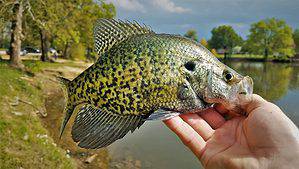
Crappie is a panfish that is very plentiful and popular in freshwater lakes and rivers. There are two types of crappie fish – black and white crappies. Even though there are some differences in their habits and color patterns, you can easily catch both with a little patience.
They travel in schools, so it is easier to catch several quickly. They are a great favorite for kids to catch.
In North America, there are many fishing tournaments for crappies; check out crappieusa.com for more information. Anglers use a variety of lures and baits to catch crappie. However, the most effective baits are jigs and live minnows.
You can generally catch crappie in the spring in shallow water. For the rest of the year, they migrate toward deeper waters. Since they can also survive in cold water, you can also catch them during ice fishing season. They put up a decent fight and tussle, which can be a lot of fun!
Crappies also taste pretty good; they have a lighter flavor than most other fish. Being part of the panfish group, they are plentiful and easy to catch.
Tip: The difference between white crappie and black crappie is to count the number of spines in the dorsal fin. Black crappie has seven or eight spines in their dorsal fins, and white crappie only has six.
Largemouth Bass
To almost every angler, the largemouth bass does not need any introduction. They originated in Eastern and Southeastern parts of America, but they have spread all around the country now. They prefer slow-moving water bodies and are commonly found in farm ponds, rivers, small creeks, and lakes.
It adapts to different kinds of water temperatures. This has played an important role in their successful propagation. Largemouth bass usually spawns in spring; depending on your location, the timing can vary from January to June. There are numerous fishing tournaments for largemouth bass fishing in several states. These tournaments are even shown live on fox sports TV!
They have huge mouths and a broad tail. They actively chase lures and baits in open water, and many anglers catch largemouth using live bait such as nightcrawlers and minnows. Some anglers go with artificial lures with equal success. From spinnerbaits and spoons to plugs and soft plastic baits, you can use various lures and artificial bait for largemouth bass.
Largemouths are one of the most popular bass to eat. Like all bass, they have a “clean” taste and have firm white flesh that is tender in texture and few bones in the fillets. The flavor of largemouth bass is somewhat mild or watery.
Smallmouth Bass
Like the largemouth, the smallmouth bass is also an extremely popular fish for anglers in North America. The smallmouth is possibly the hardest-fighting freshwater fish in North America and is commonly the target species in many freshwater fishing tournaments across many states.
They are native to the Midwest but have successfully been introduced all over the country. They tend to prefer clear, cool waters and are easy to catch.
They can be caught using multiple fishing methods, conventional spinning, baitcasting gear, and fly fishing tackle. Using live baits such as minnows is very rewarding, as well as other natural baits such as nightcrawlers and leeches. Using lures such as spinners, spoons, and small plugs work well for these fish.
Smallmouth bass is a predator fish, eating any small enough creature found in their habitat that they can swallow. Generally a daytime feeder, smallmouths are incredibly voracious early in the morning and at dusk. In the summer months, they’ll often hunt for prey at night.
Their habitat affects their weight, shape, and even color. Lake fish are more oval-shaped than those from the rivers, which tend to be more torpedo-shaped. The stream smallmouth is a darker brown, with the lake fish being a yellow-brownish color helping it hunt more effectively.
The smallmouth bass is found in clearer water than the largemouth. They are fond of the rocky areas of streams and rivers. Tree stumps and other natural obstacles are favorite haunts, also the sandy bottoms of lakes and reservoirs.
It is a cleaner, more delicate fish with a milder, sweeter taste than the largemouth. The white meat has a firm texture, white meat, and is slightly less fishy.
Largemouth and smallmouth bass are just two of the bass species that can be caught in the United States; check out my article on all the different bass types here!
Bluegill
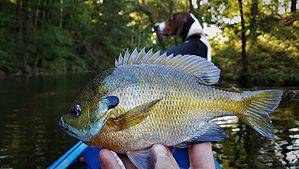
A firm favorite with most anglers, the bluegill is likely to be the first fish most of us have ever caught! They are easy to catch, and although smaller, they can surely be biting on your bait when others are not. Kids have a great time with these small popular fish.
Identifying them is easy; they have a round black spot on each side of the head close to the edge of the gills.
A Bluegill is part of the sunfish family and lives in most streams, rivers, lakes, and ponds. It tends to like to be near tree stumps and other underwater covers. They inhabit deep or shallow water and generally move about from one to the other throughout the day.
The most common baits to use are night crawlers because they are easy to find, and bluegill loves them. Try to use small worms as most natural baits, such as crickets and grasshoppers, are very easy for anglers to catch bluegills with. Artificial baits and lures also work well for bluegill.
Basically, Bluegill will eat whenever they can and whatever is on offer!
Bluegill has an awesome taste and a very sweet and delicate flavor. Smaller than crappies, they are best fried as whole fish after gutting and cleaning with a great quality fishing knife.
Catfish
There are more than 40 species in the USA, and three stand out amongst the others – Flathead catfish, channel catfish, and blue catfish. As with all catfish, they are predatory fish. Catfish can live in any type of water from lakes, ponds, rivers, and streams.
The Flathead catfish is the most widely found, and the adults eat live fish of many different types. They are quite easy to target if you are using live bait.
They are also known as shovelhead catfish or yellow catfish. They can grow over 100 pounds. The channel catfish weighs up to 20 pounds on average.
Channel catfish and blue catfish are scavengers; both have grown abundantly since they were introduced in North America. Blue catfish are the largest North American catfish and can weigh up to 150 pounds.
Catfish have smooth, scaleless skin and four pairs of trademark whisker-like barbels around their mouth. They have one spine on each pectoral fin (shoulder) and long spines on their dorsal (back) fin.
All catfish taste extremely good! But due to its diet, the flathead catfish is known to most as the best. The texture is flaky and firm but a little less firm than the blue and channel catfish.
If you want to learn more about catfish fishing, including the best bait, tips, and gear, please check out my in-depth article on the big three here!
Tip: In many parts of the Southern United States, catfish are caught with bare hands. This is commonly known as “noodling.” The noodler places their hands inside a suspected catfish hole and grabs the catfish.
Northern Pike
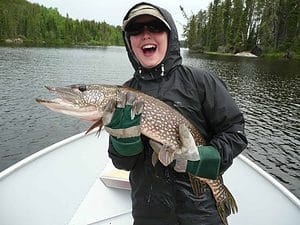
Northern pike is a very sought-after recreational fish in the United States and an important commercial fish in Canada. They are widespread across Northern America but are more plentiful in the colder states.
Pike are renowned for their fighting abilities and are very strong and persistent – they seem never to want to give up!
Northern pike is usually solitary fish and highly territorial. Being predators, they prefer to eat small live fish but also dead fish such as mackerel. They can easily be caught on spoons and other lures. Tip-ups can be used when ice fishing very effectively.
They prefer colder water, and anglers successfully catch them in winter. They thrive in clear vegetated lakes, quiet pools, creeks, and most rivers.
Northern pike is a deliciously tasty fish when cooked correctly. Pike have been served up for hundreds of years. Whilst the flesh is firm; it is a very bony fish and sometimes troublesome and difficult to eat.
Carp
Carp are native to Asia and some parts of Europe but have been introduced and even naturalized across most of the globe. They are hardy, prolific breeders and can live in almost any ecosystem.
Carp fishing in the USA is finally growing in popularity. Considered a “trash” fish by many, it has a small following of specimen anglers, similar to carp anglers in the UK. However, carp is an invasive species and causes widespread devastation to vegetation. Secondly, their abundance has created a major problem in the U.S. Many anglers in certain US states have reported a significant drop in their normal bass catches due to vast numbers of carp.
You can read more on this controversial topic here nwf.org/Our-Work/Environmental-Threats/Invasive-Species/Asian-Carp.
Regarding bait, carp eat anything! There are too many options for me to mention in this article! Traditional favorites such as corn, worms, bread, and dough baits will always work well.
Many people feel carp are an acquired taste. However, if caught from clean water, kept in an ice cooler, and before cooking, you should remove all the flesh with the bloodline; it will be more subtle and a better-tasting fish.
The Most Difficult To Catch In The List!
Walleye
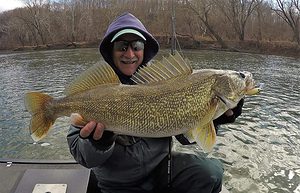
The walleye is one of the most sought-after fish in the Northern USA and Canada. Whilst they look similar in shape and size to the northern pike, they are actually from different families. Walleye are the largest fish in the perch family, and pike belongs to the Esox (pike) family.
They fight well like the pike, and a large one over 10 pounds can be challenging for kids or inexperienced anglers. Walleye will attack the bait, unlike the pike, which tends to wait for the bait to come towards them before pouncing. Therefore, catching walleye with lures and jigs is the most popular, but live baits and dead baits, crankbaits, etc., are also great choices to use.
The Upper Midwest and the Great Lakes are the native centers of the Walleye populations. They are particularly common in Canada.
Walleye are mainly olive and gold in color, with a whiter underside. They are 15” in size on average and usually weigh around 5 pounds. They are bottom feeders as well as nocturnal feeders.
Walleyes usually inhabit deeper waters, while pikes live in more shallow waters.
Walleye has a sweet and subtle flavor of white color meat and has a mild taste. The firm, fine-flaked fillet has fewer bones than the pike fish. Making it a better choice for eating.
Rainbow Trout
Rainbow trout are similar in shape to salmon. The body is heavily speckled, and a pinkish lateral stripe runs lengthwise along its sides. The forked tail has prominent black spots. The back is an olive color; its underside is a silvery whitish shade.
They are usually found in small rivers and streams throughout the United States. They become greyish-silver when they leave the streams, go towards open water waters, and slowly lose their rainbow colors. They usually prefer cold, clean, fresh water but can do well in warmer waters.
Trout can be caught using flies, lures, and other natural baits such as worms and crickets. They can be difficult to catch in areas where they rarely see anglers. Stalking them slowly sometimes is the best method to avoid them being spooked.
Rainbow trout taste much similar to salmon. Rainbow trout have a mild but nutty taste. They have a pink flaky look and texture and are delicate when cooked.
Salmon
Another great option for game fishing is Salmon. They are amazing game fish but are not easy to catch and require some skills to catch them. There is limited range and availability to catch them in certain states of the US. Alaska is the most renowned state for salmon in North America.
All salmon are strong predators that like cold water. They usually are in the sea, but they move into freshwater to spawn. During this season, the salmon change color and shape to give them the best conditions to mate.
There are six different kinds of salmon in North America, Coho, Chinook, Sockeye, Pink, and chum on the Pacific and Atlantic salmon on the east coast.
Tip: Anglers call the Chinook Salmon “King salmon,” which are very large in size. They are found all over Canada and the United States.
Pink Salmon is the most abundant yet smallest type of Salmon. They were originally present in the Sacramento River North but have successfully been introduced to the Great Lakes.
You can catch them traditionally using flies, but trolling with live bait is also popular. Spinners and spoons are the best lures to use. Salmon eggs are one of the goto baits used by many salmon fishermen; if fresh eggs are unavailable, artificial baits are an excellent substitute.
In the river system, salmon will look for safety and shelter locations. Any location where there is a natural break in the main current, especially large rocks where can save energy. Runs and pools with deeper water are their preferred hideouts.
Everyone has eaten Salmon! Out of the entire list, this is one fish that is known not only in North America but throughout the world.
Pink salmon is the smallest species and is typically used for food canning to be sold in supermarkets and grocery stores.
Sockeye is known as the tastiest of all of North America’s salmon species. Also known as Red salmon, they have fatty dark meat and are the most expensive to buy!
Sturgeon
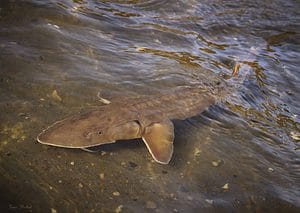
Sturgeon is a very unique fish and not easy to catch and also not very abundant in North America. There are eight species of sturgeon in North America, Atlantic, Shortnose, Lake, Shovelnose, Pallid, Alabama, White, and Green Sturgeon. The Green Sturgeon is the most commonly found. Sturgeons spend more time in marine environments, only traveling to the rivers to spawn.
Sturgeon, like salmon, can be found in landlocked lakes. Lake sturgeon are readily found in the Great Lakes Basin and can be caught in the Missouri and Mississippi rivers.
Sturgeon can live up to 100 years old, and the white sturgeon is the largest freshwater fish in North America.
Tip: To ensure the species’ continued survival, all species of sturgeon and paddlefish are listed in the Appendices of the Convention on International Trade in Endangered Species (CITES). As a result, all international trade in sturgeon is regulated.
Sturgeons are mainly composed of cartilage and have external bony plates along their sides and back. They have four pairs of barbels around their mouths, which are believed to have sensory glands.
Sturgeons are opportunistic bottom feeders. Their siphon-like mouth acts like a vacuum for sucking up worms, insects, crustaceans, and fish from the bottom.
White sturgeons are the largest and can grow to be more than 14 ft and 1500 pounds.
You might feel like eating sturgeon because they are famous for their roe (caviar). Using sturgeon as a food source in North America and many other countries is controversial at best. Protecting the species to prevent extinction is a global priority.
Final Thoughts
So what is your favorite fish? With such a huge diversity in North America, we are spoilt for choice.
Hopefully, this article will give you some ideas on catching a new species and inspire the family to go on a fishing vacation to a new destination and target different fish!
Ensure you have a valid fishing license for the specific state where you intend to fish.
- 5 Best Fishing Bags For Getting Your Gear Organized - January 13, 2025
- 4 Essential Surf Fishing Rigs - January 11, 2025
- How To Know The Sex Of A Fish You Have Caught? - December 9, 2024

